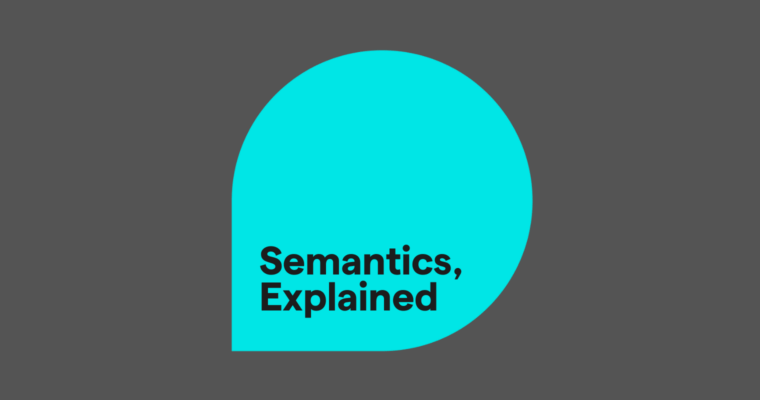
Semantics is a core branch of linguistics, the scientific study of language. It focuses on a sentence’s meaning. More specifically, it involves how grammatical structure, word choice, and context work together to create that meaning. This concept goes beyond a literal interpretation of the sentence—consider figurative language and how synonyms can carry significantly different connotations.
In this post, we will define semantics further, illustrate the differences between semantics and syntax in linguistics, and explore how both play key roles in shaping communication.
Table of contents
Semantics definition and types
Semantics vs. syntax: What’s the difference?
Semantics in everyday language
Semantics definition and types
Semantics is the branch of linguistics that studies the meaning of words, phrases, and sentences. Take a look at this sentence:
- Tomorrow, the bus will take us to the museum.
There’s a lot of information in this short sentence. Semantics defines and explains how we interpret that information. The first word, tomorrow, modifies the rest of the sentence by telling us when the action will occur. The phrasing “the bus will take us” communicates how we’ll get to the museum.
Compare that to a similar sentence:
- Tomorrow, we’ll take the bus to the museum.
The meaning is essentially the same. But through slightly different wording, we can infer two different situations. The first might mean that the bus has already been chartered, and the plan to visit the museum has been in place for a while. The second might mean that the speaker will drive the bus, or the group will ride a regularly scheduled public bus. It might also indicate a more spontaneous museum trip than the first sentence.
That’s semantics in action. It enables us to understand what sentences mean, rather than just what they say.
Main branches of linguistic semantics
In linguistics, semantics is a broad category. There are many different ways words convey meaning, and within semantics, there are names for each of these ways.
| Main Branches of Linguistic Semantics | |||
| Semantic Type | Focus | Key Concepts | Example |
| Lexical semantics | Word meaning and relationships | Homonyms, synonyms, antonyms, polysemy, taxonomy | Bank = a place that handles money, or a river’s edge |
| Compositional semantics | Meaning from word combinations | Literal vs. idiomatic meaning | She kicked the bucket. (An idiom for death vs. the action of kicking a bucket) |
| Phrasal semantics | Meaning of sentences | Sentence structure, subject-predicate relationships, modifiers | The dog chased the ball. (Subject-dog, verb-chased, object-ball) |
| Contextual meaning | Meaning shaped by context | Tone, setting, cultural cues | I’m fine. (Varies by tone/expression) |
| Formal semantics | Logical structure of meaning | Propositional/predicate logic, ambiguity resolution | Every student read a book. (Can be interpreted in multiple ways) |
Pragmatics: Beyond literal meaning
Within semantics is an area of study called pragmatics. It’s the study of how words’ meanings are shaped by context, intention, and social rules. When you ask the following questions, you’re exploring pragmatics:
- What does the speaker really mean?
- How do tone, body language, or shared cultural knowledge influence interpretation?
- Why do people often say one thing but mean another?
Pragmatics fits into semantics because while both involve decoding sentences’ meanings, pragmatics often answers the questions semantics raises. Here are a few examples of pragmatics in action:
- When someone says, “Can you pass the salt?” they’re not asking if you’re capable—they’re politely requesting that you do it.
- The phrase “Nice job!” could be genuine praise or sarcastic criticism, depending on tone and situation.
Key takeaway: If semantics tells us what words can mean, pragmatics tells us what speakers actually mean in a given moment.
Semantics vs. syntax: What’s the difference?
Semantics and syntax are similar, but not the same thing. While semantics is the study of how words and sentences create meaning, syntax is the set of rules that govern how words are arranged to form grammatically correct sentences.
Syntax can support semantics, but it’s also possible to have a syntactically correct sentence with no meaning. You can also write or say a sentence that’s not syntactically correct, but clearly communicates an idea. Here are two examples:
- Syntactically correct, but meaningless: “Colorless green ideas sleep furiously” (Chomsky).
- Syntactically incorrect, but the meaning is clear: “Me go store.”
Key takeaway: The difference between semantics and syntax matters because they’re two distinct principles that make language easy to understand. While semantics ensures understanding, syntax ensures structure. It’s possible to follow grammatical rules and still write a confusing sentence or break the rules and be understood, but a strong understanding of both minimizes your likelihood of being misunderstood.
How semantics and syntax work together
While syntax shapes how we interpret words’ meaning, semantics helps us decode that meaning. Compare these two sentences:
- “The dog chased the cat.”
- “The cat chased the dog.”
While the syntax pattern is the same, these sentences’ semantics are different. Those different semantics are why these sentences evoke different images in your mind.
Key takeaway: Syntax builds the sentence’s framework, while semantics gives it meaning. Effective communication depends on balancing structure and meaning.
Semantics in everyday language
Although you probably don’t consciously think about it, semantics are at work every time you communicate. Think about the times you’ve misunderstood others or they’ve misunderstood you—the wrong word or awkward phrasing was likely the reason why.
Think about the words and phrasing you frequently use to communicate, too—perhaps you use “literally” for emphasis, rather than according to its primary definition. Words and language evolve, and because “literally” has outgrown its original meaning, people understand what you mean when you use it that way.
Semantics and wordplay
Wordplay is a way to have fun with semantics. This is because a lot of puns and jokes hinge on words’ double meanings, like:
- What did the buffalo say to his son when he left home? Bison.
- Broken pencils are pointless.
- I was reading a book about anti-gravity. I couldn’t put it down!
In many cases, wordplay can’t be translated, because it relies not only on words’ meanings, but also on their cultural context. One example is this famous exchange from the film Miss Congeniality:
“Describe your perfect date.”
“I would have to say April 25 because it’s not too hot, not too cold. All you need is a light jacket.”
This joke doesn’t work in translation, because in many languages, the word for a social engagement isn’t a homonym for the word meaning a day on the calendar.”
Antonyms and synonyms are also common features of wordplay, and similarly they don’t always translate.
Semantic variation across languages
Every language has its own semantics. This is also why some words and concepts are difficult or even impossible to translate directly into another language. One example is the concept of hygge, a Danish word that describes the intimate, genial feeling of sitting around a fire with close friends during the winter. English speakers can certainly imagine and understand the sense of hygge, but the word itself can’t be translated into a single English word—as you see, it can only be described.
One of the biggest challenges translators face is maintaining the original meaning of a writer or speaker when translating their work into a new language. This is because some words are untranslatable and because certain ideas and perspectives are culturally specific.
Sometimes, this means deviating significantly from the original text to capture its meaning more effectively. In other cases, translators deem it better to stick close to the original text, sacrificing some of its meaning. It’s a nuanced practice that makes translation a combination of art and science. It’s also why skilled translators are more than just fluent in multiple languages; they know how to navigate linguistic relativity and understand how language influences the way we perceive the world.
Why semantics matters
In communication, semantics matters because it enables you to express yourself clearly. When you can pinpoint words’ meaning and choose the best words for the point you aim to make, you’re better equipped to express ideas logically and persuasively. In other words, you don’t just say things right—you say the right things. This is important in all forms of communication, from casual chats to formal academic and professional writing.
Real-world applications of semantics
We’ve talked a lot about semantics in academic theory. Beyond this, semantics drives technological advancement and your daily communications. A few examples of semantics in action include:
- Comprehension. Understanding semantics enables you to interpret figurative language, like metaphors and similes, and trace bias in the content you read.
- Communication. Similar to above, a strong grasp of semantics enables you to communicate effectively in a variety of settings, such as professional and academic contexts. For example, communication in a global setting must be precise, as not all participants have the same cultural background or understanding of English. However, with a group of close colleagues or classmates, adjusting your tone and vocabulary can help you communicate ideas and feelings beyond the words you say.
- Technology. Virtual assistants like Siri and Alexa are built to understand spoken language through a branch of artificial intelligence known as natural language processing (NLP). NLP relies on proper semantics to function.
Semantics is a prominent part of many other technical and humanities fields. These include:
- computer science / programming semantics
- philosophical semantics
- cognitive semantics
- formal semantics (logic and math)
- semantic web
No matter the field, semantics centers on how meaning is built, interpreted, and used to make systems and communication more precise.
Semantics FAQs
What is semantics in language?
Semantics is the study of meaning in language—how words, phrases, and sentences convey meaning and how that meaning is interpreted.
What is “arguing over semantics”?
Arguing over semantics means focusing on the exact meaning or choice of words in a discussion, often when the overall point is already understood. It can suggest that someone is focusing on language rather than addressing the main issue.
What are the main branches of linguistic semantics?
The main branches include lexical semantics (word meaning), compositional semantics (how meanings combine), and truth-conditional semantics (meaning based on truth in context).
How is semantics different from syntax?
Semantics focuses on meaning, while syntax deals with the structure and rules of sentence formation.
What does pragmatics add to our understanding of meaning?
Pragmatics examines how context, speaker intent, and social factors influence the interpretation of meaning beyond the literal words used.
Why is semantics important in real-world communication and technology?
Semantics helps improve clarity in communication and is vital in AI, search engines, and language processing technologies for accurate understanding and response.






